In the competitive world of fishing charters, first impressions matter. For many potential clients, their decision to book a trip often comes down to the visuals they see online. High-quality photos and videos don’t just showcase your skills—they build trust, convey the experience, and set the tone for your brand.
Whether you run family-friendly outings or cater to serious anglers chasing trophy fish, having the right visual content can be the difference between a full calendar and missed opportunities. In this guide, we’ll show you why authentic, quality imagery is essential and provide actionable tips to help you capture the content that drives bookings and effective marketing.
Why Fishing Charters Need Quality, Varied Imagery
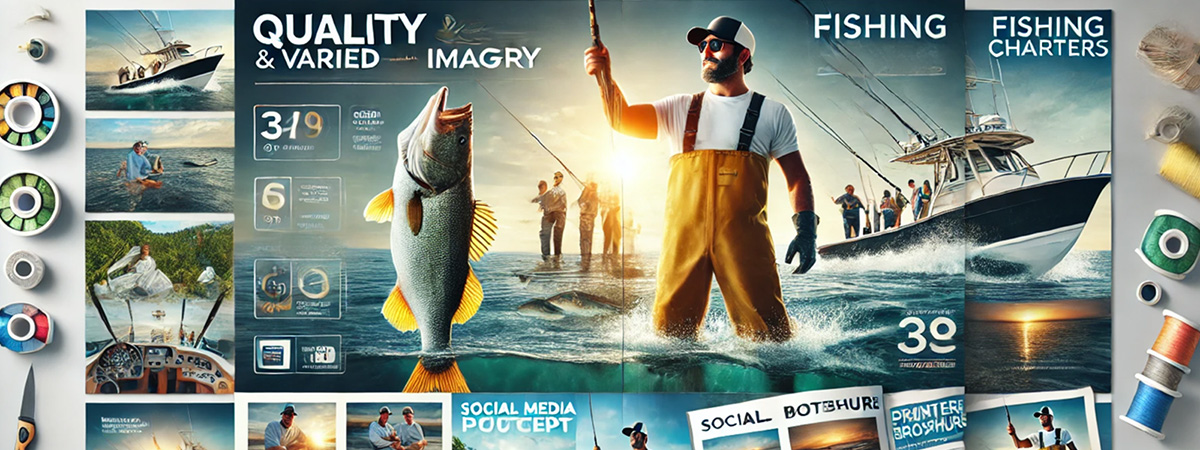
For your charter or guide business, your photos and videos are often your biggest marketing asset. They serve a range of purposes, from drawing attention to your website and filling your social media feeds to enhancing third-party booking platforms and print materials. Without high-quality, engaging visuals, you’re missing key opportunities to stand out from the competition.
Here’s where these visuals have the most impact:
- Website imagery: Hero shots, galleries, and action-packed visuals help convert visitors into bookings.
- Social media content: Consistent, captivating photos drive engagement and encourage followers to share your posts.
- Booking platforms: High-resolution images can make your listings more appealing and professional.
- Marketing materials: Google and social ads, brochures, rack cards, and business cards all benefit from strong visuals.
The right photos don’t just show what you do—they help potential clients imagine themselves on your boat, in your raft or wading with you, experiencing the adventure for themselves. In a competitive market, that emotional connection is key to securing bookings and building long-term brand loyalty.
Setting the Mood: Let Your Imagery Tell the Right Story
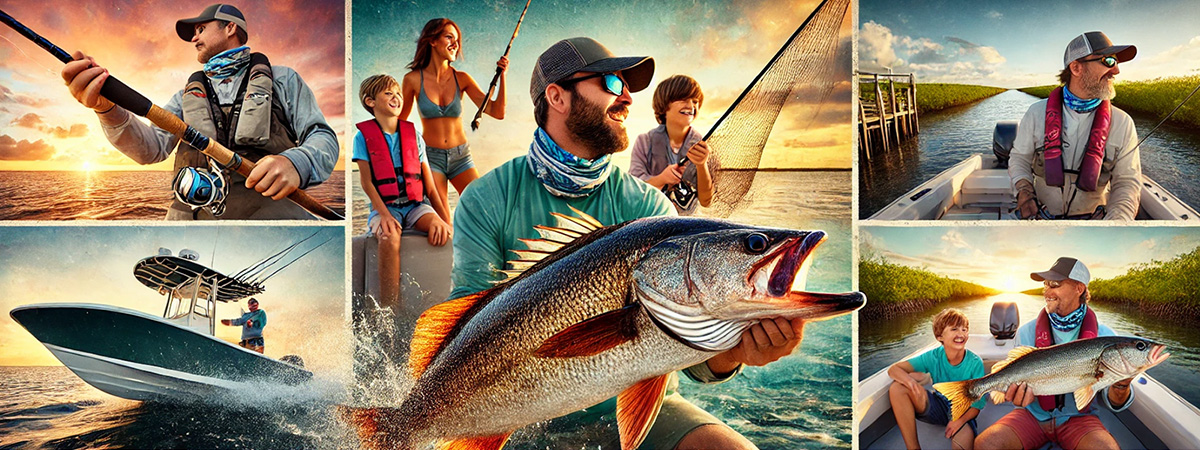
Photos and videos do more than just show off the size of the fish your clients catch—they set the overall tone for your guide service and help potential customers understand what kind of experience to expect. Whether you run laid-back family charters or high-energy, serious fly-fishing trips or hardcore offshore missions, the imagery you choose can make or break how effectively you attract the RIGHT audience.
Here are a few examples of how imagery can shape the perception of your charter and guided trips:
- Hardcore anglers: Action-packed shots of clients battling highly sought after gamefish, close-ups of trophy catches, and adrenaline-filled moments on the water.
- Family-friendly charters: Smiling kids, families enjoying time together, and easygoing, relaxed images of fishing fun.
- Tourist-friendly outings: Happy groups, laid-back vibes, and shots of scenic moments and onboard relaxation.
- Catch-and-release or conservation-focused: Respectful handling of fish, minimal “kill shots,” and images that promote sustainability.
- Serious sport fishing: Competitive energy, large trophy catches, and a focus on skill-based fishing.
When your visuals match the unique personality of your guide service, you’ll attract clients who are aligned with what you offer. Authenticity is key—showing exactly what makes your charter special builds trust and brings in the right kind of bookings.
What Makes for High-Quality Photos and Video?
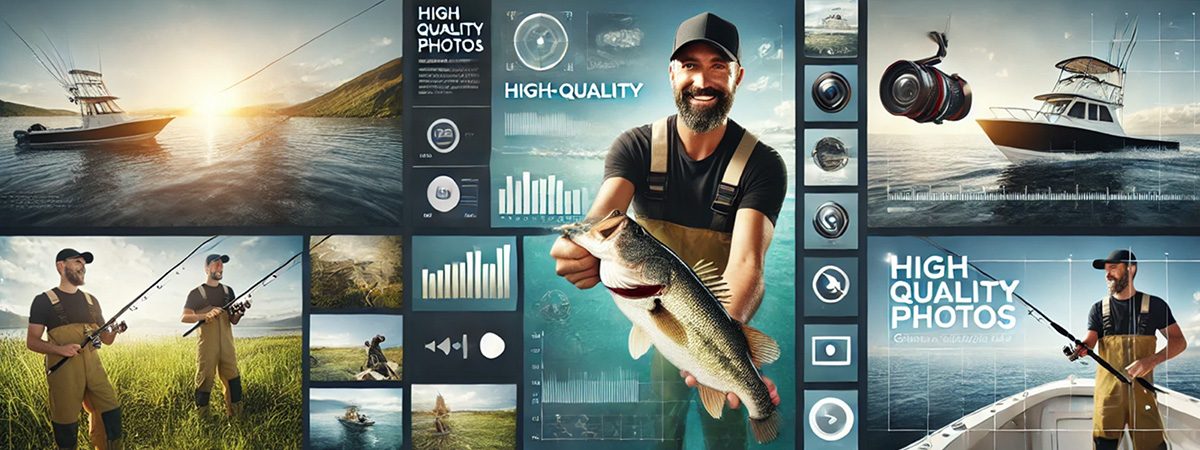
For fishing charters and guide services, high-quality imagery isn’t just about resolution—it’s about capturing the right moment, format, and emotion. While most modern smartphones and GoPros can produce excellent results, knowing what to shoot and how to format it ensures your visuals have maximum impact across your marketing channels.
Resolution and Clarity
- Use devices capable of shooting high-resolution images (modern smartphones, DSLRs, GoPros).
- Ensure photos and videos are crisp, properly lit, and in focus.
Variety of Formats
You’ll need images and videos in different orientations and formats to meet the needs of your website, social media, and marketing materials.
- Portrait-oriented photos: Ideal for close-ups of clients with their catch, captain bios, and individual shots for social media.
- Landscape-oriented photos: Perfect for hero images, website banners, action shots, and scenic backgrounds. These allow room for overlaying text or design elements.
- Video (preferably landscape): Ideal for embedding on websites, YouTube, and dynamic social media content. Portrait videos are far less versatile for web use and are best saved for platforms like Instagram Stories or TikTok.
Capturing the right combination of portrait and landscape images ensures you’re always equipped with visuals tailored to your marketing needs. Great photos go beyond aesthetics—they draw attention and drive engagement.
What to Capture: Beyond “The Grab it and Grin”
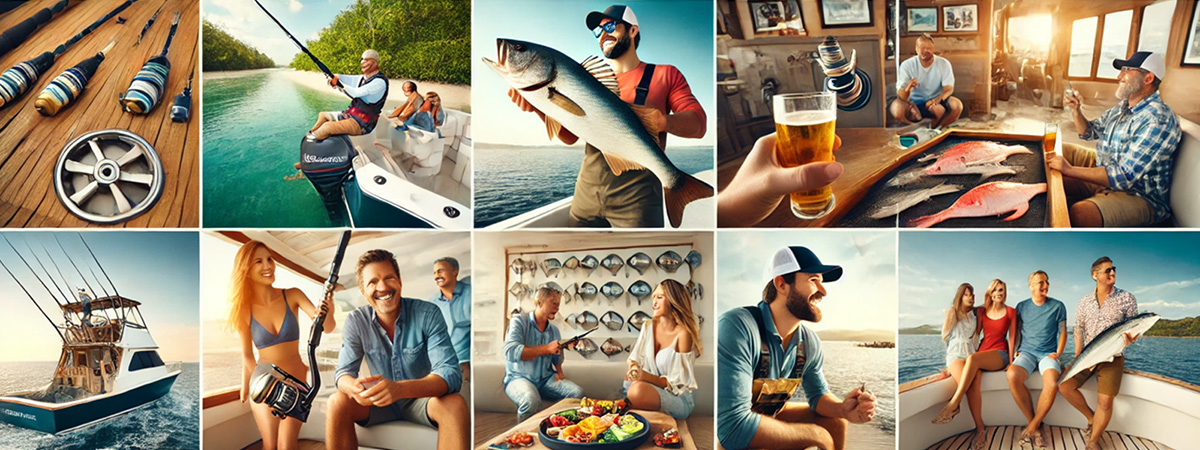
Many guides default to taking photos of their clients holding their catch at the dock or onboard the boat – the old “grab it and grin”. While these shots are important, they only scratch the surface of the visual content needed to attract bookings and effectively market your business. To stand out, you’ll want a broader range of imagery that tells the full story of a fishing trip.
Here’s a checklist of essential shots:
- Clients with their catch: Close-up and pulled-back shots of guests proudly holding their fish.
- Action shots: Clients fighting fish, reeling them in, or the boat cruising to the fishing grounds.
- Lifestyle moments: Guests relaxing, enjoying lunch on the boat, or marveling at wildlife. These create a warm, welcoming atmosphere.
- Boat and equipment: Highlight the boat, tackle, and gear setup with a mix of detailed close-ups and wide-angle shots.
- Guide and captain profiles: Candid shots of the guide interacting with clients or working on the boat. Personalized images help build trust and humanize the brand.
- Family-friendly experiences: Photos of kids, parents, and families enjoying the charter together. Essential for services catering to family outings.
- Scenic and marine life shots: Capture the beauty of the destination, from ocean landscapes to dolphins and marine wildlife.
To truly capture the magic of a fishing trip, aim for photos that show both the thrill of the catch and the overall experience. A diverse gallery will appeal to a wider audience, from hardcore anglers to families looking for a memorable adventure.
Pro Tip: Arrange a Planned Shoot
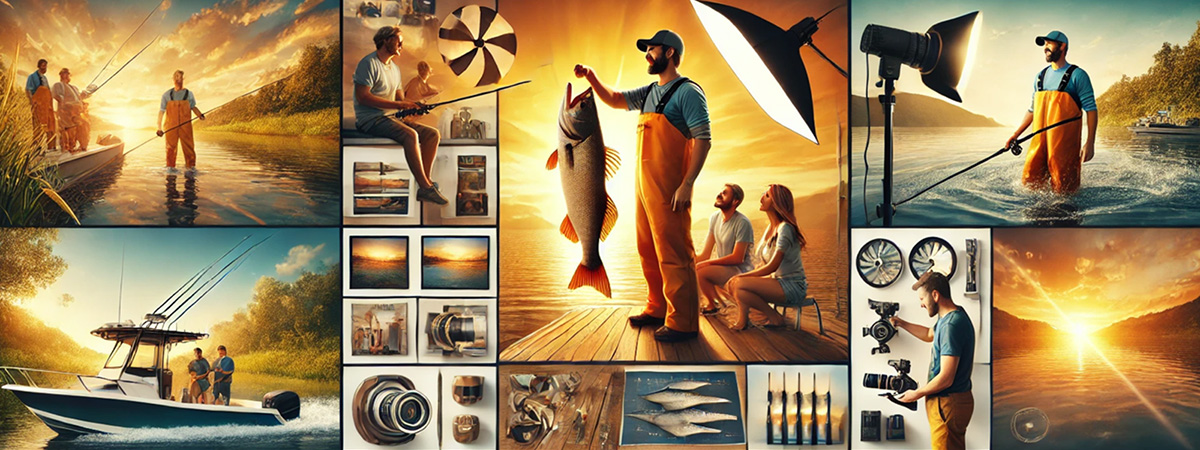
While spontaneous photos taken during charters are valuable, there’s no substitute for a well-planned photo shoot. Scheduling a dedicated session allows you to capture high-quality, intentional shots that highlight the best aspects of your guide service. This can be especially useful for creating hero images, promotional videos, and key visuals that set the tone for your brand.
Here’s how to make the most of a planned shoot:
- Use a second boat or onshore photographer: For action shots that aren’t possible when everyone is on the same boat, consider having someone follow in another boat or capture moments from shore if guiding on foot.
- Include a mix of staged and candid shots: Staged shots can ensure you get specific visuals, while candid shots capture the authentic excitement of a day on the water.
- Time the shoot around ideal lighting: The “golden hour” (early morning or late afternoon) provides soft, flattering light that enhances the quality of your photos and videos.
- Plan for a variety of scenarios: Include shots of different trip types (family charters, fly fishing, offshore trips) to create a comprehensive visual library that fits your brand.
A planned shoot is an investment in the long-term success of your marketing efforts, providing you with a bank of high-impact visuals that can be used across all channels—from your website and ads to social media and printed materials. Keep in mind, this doesn’t have to mean hiring a professional photographer—a fellow guide, a local photographer who wants to do trade, or a friend who’s handy with a camera can often do the job!
Real Success Story: Capt. Craig Clopper
One of the most powerful examples of how quality photos can drive bookings comes from Capt. Craig Clopper of Goliath Charters Key West. Craig consistently provides high-quality, authentic imagery of his charters, including photos of clients with impressive catches, action-packed moments, and scenic shots that showcase the beauty of the Florida Keys.
Craig’s effort has paid off in a big way. Several clients have told him that the reason they chose to book with Goliath Charters was because of the images they saw on his website. These photos gave them a clear picture of what to expect—big fish, exciting action, and an unforgettable experience on the water. For many potential customers, seeing is believing, and Craig’s visuals have made him stand out from competitors.
This success story highlights a crucial lesson: investing time and effort into capturing the right photos and videos isn’t just about aesthetics—it can directly impact your bottom line by converting website visitors into paying clients.
Stock Photography: A Minimal, Supportive Role
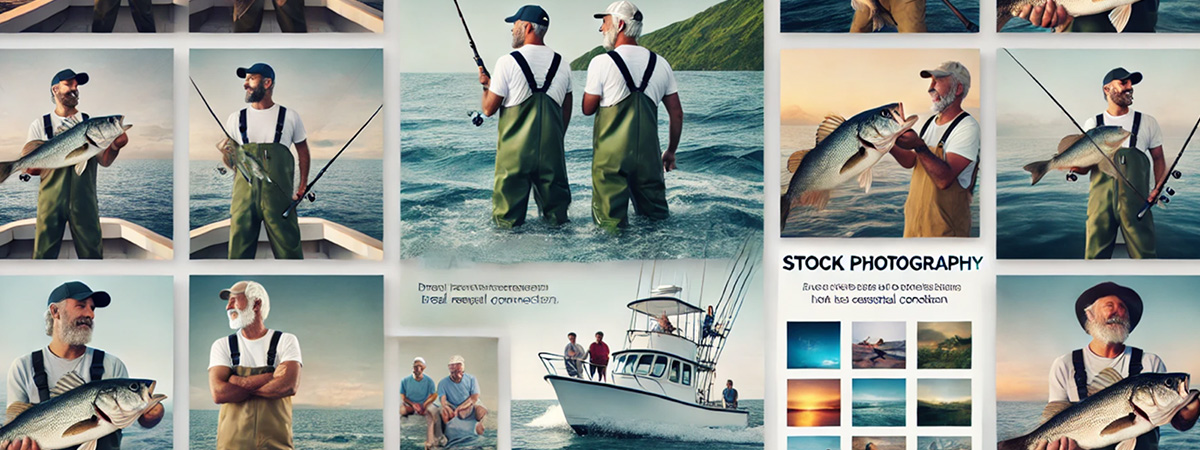
While authentic photos should always take center stage in your marketing, there are times when stock photography can fill in the gaps. Used correctly, it can help with secondary content, but relying too heavily on stock imagery can weaken the authenticity and trust your brand needs to build.
When to Use Stock Photos
- Backgrounds: Subtle, non-distracting stock images can work well as backgrounds for website sections or marketing materials.
- Filler content on non-essential pages: Stock images can be used sparingly on pages like “species” or “locations” where generic visuals are acceptable.
Why You Should Avoid Overusing Stock Photos
Stock photography often lacks the emotional connection that real photos of your charter trips provide. Generic images can also make your brand appear less genuine and more like a “copy-paste” business. Worse, popular stock images are often overused, which could result in your competitors showcasing the same visuals.
Whenever possible, prioritize real, high-quality photos taken on your charters. If you must use stock imagery, do so sparingly and ensure it doesn’t replace your core visuals. Authenticity is what will set you apart and convince potential clients to book with you.
Practical Tips to Make Image Gathering Easier
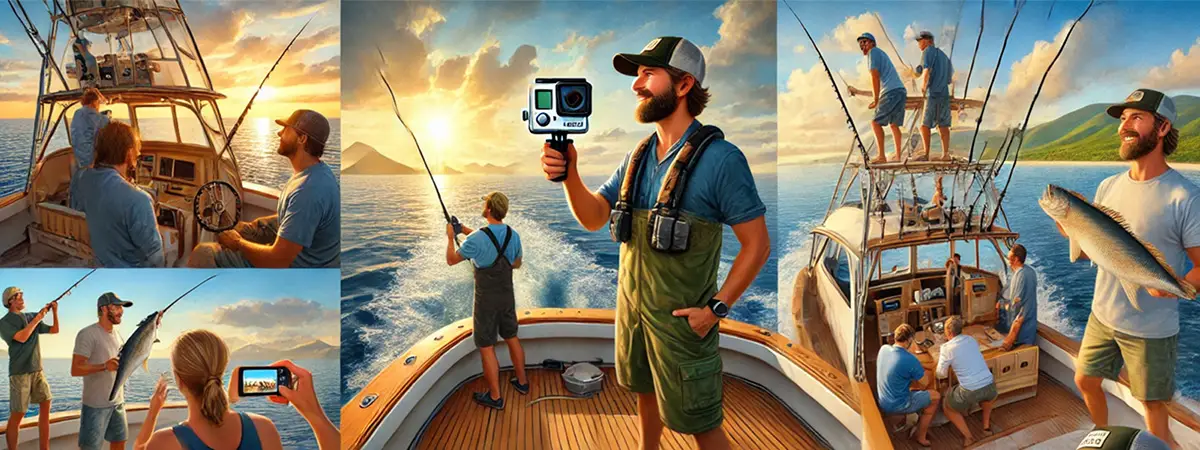
Gathering high-quality photos and videos doesn’t have to be time-consuming or complicated. With a few simple strategies, you can consistently capture content that elevates your marketing efforts and drives bookings. Here are some practical tips to help you get started:
- Keep a smartphone or GoPro handy: Always have a device ready to capture spontaneous moments. Waterproof action cameras like GoPros are perfect for capturing the excitement of fishing in dynamic environments.
- Designate someone to help: A deckhand, first mate, or even a guest can take photos during the trip, freeing you up to focus on guiding while still capturing key moments.
- Create a checklist of must-have shots: Include action shots, close-ups of catches, scenic views, and lifestyle moments. This will ensure you get a diverse collection of images from each trip.
- Review and organize your photos regularly: At the end of each day or week, review your photos and videos, delete any that don’t meet your quality standards, and save the best to a dedicated folder for marketing use.
- Encourage clients to share their photos: Many guests take photos during the trip. Ask them to share their best shots with you, and be sure to credit them when you use the images (with their permission).
By making image gathering part of your regular routine, you’ll build a valuable library of visuals that are ready to use across your website, social media, and marketing campaigns. If you have any questions or want advice on creating an effective content strategy, lets chat—we’re happy to help!